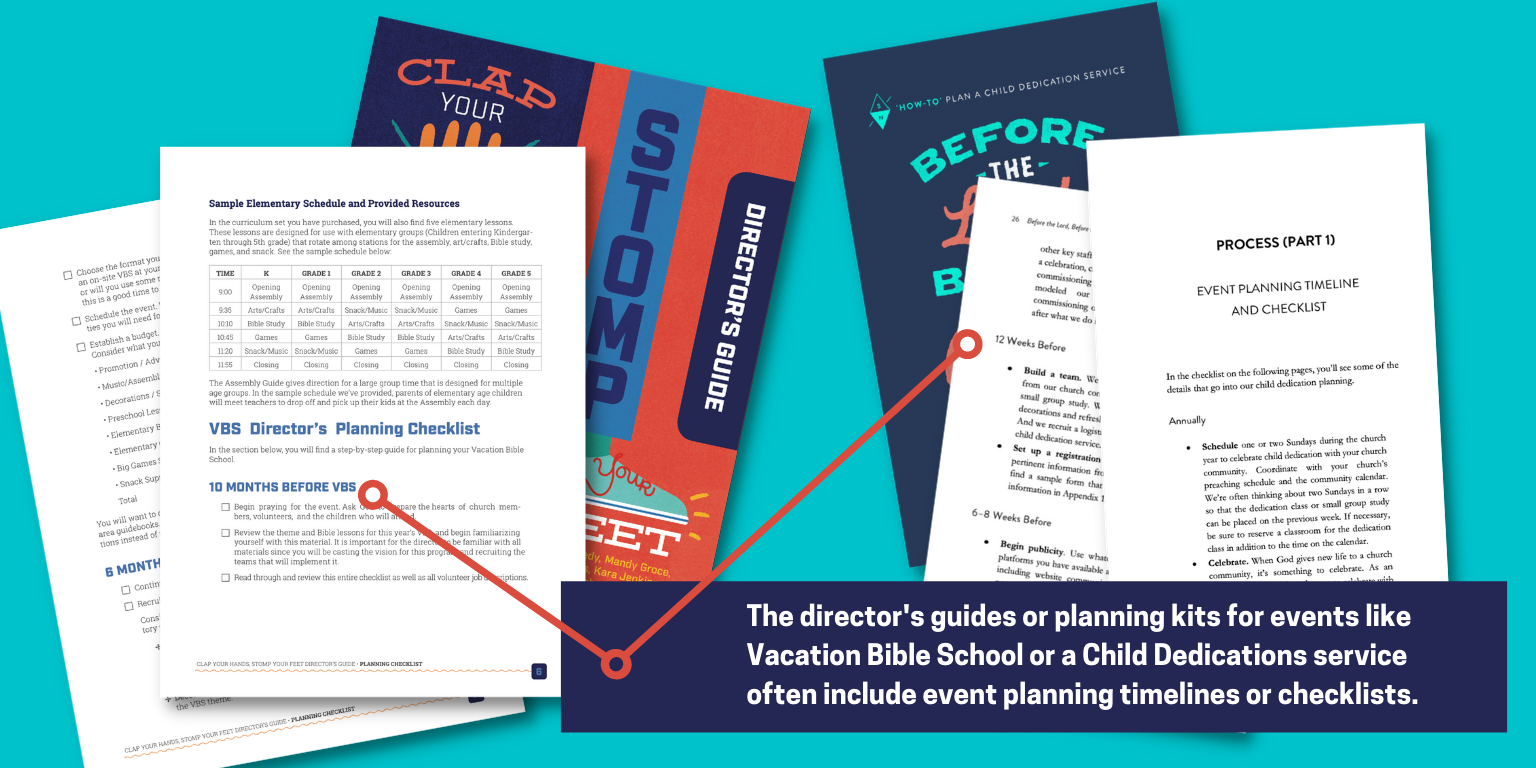4 Tips for Children's Ministry Event Planning and Communication
A few weeks ago, a pastor friend who supervises children’s ministry staff at his church reached out to me and asked, “If you were coaching a children’s ministry leader on event planning and communication, what tips would you give them?” My friend’s question is a great one. After all, children’s ministers have a lot of people with whom they need to communicate.
When planning for events or ministry initiatives, it’s important to be on the same page with other church staff. On at least a weekly basis, it’s necessary to have regular communication about the service schedule and weekly teaching plan with your volunteers. And speaking of volunteers, it’s essential to have a clearly communicated assimilation process—application, background check, interview, and training—for those who desire to begin serving in the ministry for the first time. Oh, and I haven’t begun to talk about the need to communicate with parents, to promote events through regular announcements, and to think intentionally about how your ministry might use social media as an equipping resource.
Many children’s ministers stepped into their ministry roles with backgrounds in education—even Christian education—but fewer of us had training in event planning and administration when we began. We might know how to interpret the Bible and teach the next generation, but we have a lot to learn about managing a ministry.
With these realities in mind, I forwarded my friend’s question to several organized ministry leaders that I know. Here are their encouragements:
First, begin your communication about events or ministry initiatives as early as possible.
Sandra Peoples, who is a disability consultant for the Southern Baptists of Texas Convention and a women’s and disability ministry leader at Heights Baptist in Alvin, Texas, told me, “At our church, anything that’s going on the calendar needs to be requested at least two months in advance. It gets discussed and approved at staff meetings. Then, we begin the planning process.”
I love Sandra’s idea of a two-month planning minimum, but for larger, church-wide events like vacation Bible school or a community harvest festival—or with any communication of events in a very large church—the communication will need to start even earlier. In his article, “Leadership and Church Size Dynamics: How Strategy Changes with Growth,” Dr. Timothy Keller makes clear that an increasing redundancy of communication is even more necessary as a church grows. Keller writes, “Without multiple forms and repeated messages, people will feel left out and complain, ‘I wasn’t told about it.’ You know you’ve crossed into a higher size category when . . . informal communication networks (pulpit announcements, newsletter notices, and word of mouth) are insufficient to reach everyone.” Once that is the case more lead time is necessary to communicate effectively; fluency is the goal. As Heather Thompson, communications director at Paradox Church in Ft. Worth, Texas, told me, “When you are tired of saying it, that may be just the beginning of people starting to get it.”
Second, as you plan the event, use a checklist.
If you’ve purchased a vacation Bible school director’s guide or any sort of event planning kit from a Christian publisher, you’ve likely discovered that those kits contain planning timelines or checklists that begin up to a year in advance. Peoples told me that an event planning checklist her church uses includes details like “room setup, registration, graphic design, turning on the AC, and getting keys to whoever needs them.” But the checklists also cover matters of communication.
In fact, directors’ guides and resource kits may even include sample email communication for volunteers and parents or promotional materials such as videos, posters, mailers, and graphics for the church bulletin or social media. One of the great things about these kits is that they not only give you these resources for communication, they also tell you exactly when in the planning process to use them.
When planning an event without any sort of pre-set guide or kit, I’ve often taken a planning checklist that I’ve used before (for an event like child dedication, for example), and then I’ve adapted it as a template for the new event. I just make any necessary adjustments (e.g., enough recruiting lead time for events that require more volunteers) and then follow the checklist step-by-step.
Third, be consistent with your regular communication.
Consistency with the channels you use to communicate will help the parents in your church and the volunteers who serve in your ministry know where to find the information they need. If, for instance, you’re consistent with sending out the children’s ministry schedule and curriculum via email each Tuesday morning, teachers will learn to look for it on that day in their Inbox. It can be possible to use too many communication platforms, narrowing your communication to one landing page on your website and the most used social media platforms can make your communication more clear.
Jared Crabtree serves as pastor of Families at Redeemer Fellowship Midtown in Kansas City, Missouri. He told me that his team works to have a presence on Facebook and Instagram that follows a regular schedule—“typically a video with one of our staff or leaders teaching hand motions for the lesson memory verse on Mondays and something like an activity or resource for families on Wednesday or Thursday as well as regular volunteer highlights.”
I love that the Redeemer team is intentional about celebrating volunteers, because, as Thompson told me, “Regular communication should not just revolve around announcements, promotions, or policies. Great communication is an ‘encouragement channel’ that celebrates what you value; it’s consistently communicating your vision and values for your team and the people you serve.”
Sandra Peoples highlighted another reason for a consistent communications schedule or planning checklist. It minimizes decision-making. “You don’t have to think of everything every time,” she said. “Make one decision that you can apply over and over when possible. I do this in dozens of ways. I have assigned days for posts on social media and a schedule for what I want to share; I also wear the same shirt every Monday, and we always have the same meals on the weekends.”
I get it. We have Taco Tuesdays and Tuscan Thursdays (pizza or spaghetti) every week at the Kennedy house! As Peoples told me, “It may feel restricting for creative types at first, but then they realize how much brain space they have for the things that really matter when they put the rest on auto-pilot.” Planning in advance when you’re going to post on social media gives you the opportunity to be more deliberate about what you say and the tone with which you say it. It also gives you the time to have a well-rounded plan that addresses each of your target audiences — parents, children, and team members. Planning ahead gives you the opportunity to be prayerful, deliberate, and intentional.
Finally, make event planning and communication a team project.
Rachel Mills and Alix Carruth, who serve with Crabtree at Redeemer Fellowship, run one of the best children’s ministry Instagram accounts I’ve seen. To help with consistency, they’ve put together a shared spreadsheet that maps their regular social media posts, and they use Slack, a team communication app, to share ideas for headlines. Carruth told me, “We alternate days of posting on Facebook and Instagram, but we meet every two weeks to plan for two weeks in advance so that we can be two weeks ahead.”
Working together makes Mills and Carruth’s work lighter. Teamwork makes the dream work! It provides built-in accountability, too. Whether you’re leading a children’s ministry as a volunteer, serving as the only staff member, or part of a larger team, it’s important that you find others in your church who can help you bear the communication load.
All leaders communicate, and as Proverbs 25:11 (NKJV) says, “A word fitly spoken is like apples of gold in settings of silver.” If you are a children’s ministry leader, you have a unique communication burden due to the numerous communication channels you have to manage — with fellow church staff, volunteers, parents, and the congregation as a whole. It’s one that can be carried with God’s help. By prayerfully planning ahead, using a checklist, being consistent, and working with a team, you can communicate in a way that’s gentle, intentional, and effective.



